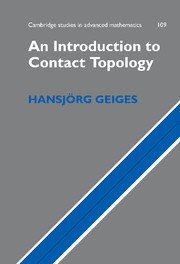Book contents
- Frontmatter
- Contents
- Preface
- 1 Facets of contact geometry
- 2 Contact manifolds
- 3 Knots in contact 3—manifolds
- 4 Contact structures on 3—manifolds
- 5 Symplectic fillings and convexity
- 6 Contact surgery
- 7 Further constructions of contact manifolds
- 8 Contact structures on 5—manifolds
- Appendix A The generalised Poincaré lemma
- Appendix B Time-dependent vector fields
- References
- Notation index
- Author index
- Subject index
1 - Facets of contact geometry
Published online by Cambridge University Press: 05 November 2009
- Frontmatter
- Contents
- Preface
- 1 Facets of contact geometry
- 2 Contact manifolds
- 3 Knots in contact 3—manifolds
- 4 Contact structures on 3—manifolds
- 5 Symplectic fillings and convexity
- 6 Contact surgery
- 7 Further constructions of contact manifolds
- 8 Contact structures on 5—manifolds
- Appendix A The generalised Poincaré lemma
- Appendix B Time-dependent vector fields
- References
- Notation index
- Author index
- Subject index
Summary
‘After a while the style settles down a bit and it begins to tell you things you really need to know.’
Douglas Adams, The Hitch Hiker's Guide to the GalaxyThis opening chapter is not meant as an introduction in the conventional sense (if only because it is much too long for that). Perhaps it would be appropriate to call it a proem, defined by the Oxford English Dictionary as ‘an introductory discourse at the beginning of a book’. Although some basic concepts are introduced along the way, the later chapters are largely independent of the present one. Primarily this chapter gives a somewhat rambling tour of contact geometry.
Specifically, we consider polarities in projective geometry, the Hamiltonian flow of a mechanical system, the geodesic flow of a Riemannian manifold, and Huygens' principle in geometric optics. Contact geometry is the theme that connects these diverse topics. This may serve to indicate that Arnold's claim that ‘contact geometry is all geometry’ ([15], [17]) is not entirely facetious. I also present two remarkable applications of contact geometry to questions in differential and geometric topology: Eliashberg's proof of Cerf's theorem Γ4 = 0 via the classification of contact structures on the 3—sphere, and the proof of Property P for non-trivial knots by Kronheimer and Mrowka, where symplectic fillings of contact manifolds play a key role.
- Type
- Chapter
- Information
- An Introduction to Contact Topology , pp. 1 - 50Publisher: Cambridge University PressPrint publication year: 2008

